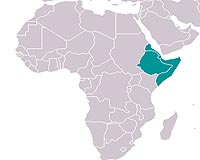| . |  |
. |
Parkes, Australia (AFP) Jan 18, 2010 Torrential rains in Australia have failed to quench the country's "Big Dry", a decade-long drought that has driven farmers to the wall and shows no signs of abating. While the rains flooded many areas in recent weeks, made parched rivers flow again and even halted the iconic Ghan cross-country train, large parts of the hot, dry country were left untouched. Ken Keith, a third-generation sheep farmer near Parkes in rural New South Wales, was one of those bypassed by the deluge. "It's probably been the driest 10 years ever, in my memory anyway," he said. "Last year was the third-driest year for the previous 40 years on this farm." North of Parkes, the rains flooded scores of towns -- the best falls for many areas in a decade. But Parkes saw only a sprinkling, just enough to raise a stubble of grazing crops. At Keith's farm, a fly-blown ewe, riddled with cancer, had collapsed near the herd's meagre water supplies. "She'll have to be shot," he said grimly, crouching over the animal. Parkes is in the narrow band identified by the weather bureau as in "serious to severe" drought, where rainfall is among the lowest it has been since records began. Despite the Christmas rains, drought extended by one percentage point to nearly 82 percent of the eastern state of New South Wales in January, officials said. Just five percent of the state is rated "satisfactory". "The recent rainfall events occur against a backdrop of decade-long rainfall deficits and record high temperatures that have severely stressed water supplies," said rural affairs minister Steve Whan. Though the "Big Dry" has eased slightly since 2006, the National Climate Centre said 19 percent of Australia remained in drought, mostly in the southeastern states of New South Wales and Victoria, and the island of Tasmania. "As a long-term drought it's certainly the worst in the Murray-Darling basin since the 1940s," meteorologist Blair Trewin told AFP. The basin, a vast river system feeding into the heart of Australian farming country, is at a critical low, with water levels at just 25 percent of capacity and distribution tightly controlled by the government. Parkes has seen other droughts, in 1982 and 1967, but never so relentless, Keith says. All but three of his farm's 40 dams are dry, and he has to feed all his 2,000 sheep by hand because the grazing pastures are withered and useless. Most people in the area are receiving government assistance and are heavily in debt. Keith was forced to shrink his herd by one-fifth last year and is contemplating trucking his animals north to graze until matters improve. Meanwhile Parkes's town dam is at just six percent capacity, and the authorities have stopped running water to some nearby smaller communities, meaning some farmers are having to bring in water by road. Some farmers have sold up all their stock and turned their land to crops such as wheat, barley and canola -- a high-stakes gamble relying on good spring rainfall. Without a nearby river for irrigation, croppers lead a precarious existence anxiously praying for rains. Some have simply given up hope. "There's certainly people that have put their farms on the market and closed the gates," Keith said. "I think some are rethinking the future now." Australia has just emerged from its hottest decade on record with events like last February's "Black Saturday", its worst ever wildfire disaster, raising fears the country is bearing the brunt of global warming. Keith said many farmers had been forced to scale down and adopt a more conservationist approach in the face of climate change. However, he feared for the future of farming in Australia, which has declined from 14 percent of GDP in the early 1960s to less than three percent, worth about 29 billion dollars (27 billion US) a year. Keith's family first started farming near Parkes 101 years ago, at a time when more than 60 percent of Australians lived in rural areas. Since the 1950s, Australia's number of farms has nearly halved to 110,000. "The disappointing part for me is that I have three sons -- 15, 17 and 19 -- and all they have really experienced is drought, low returns, and they're looking to careers in other areas," he said, gazing wearily at his yellowing paddocks. "It's a shame, the way things have gone, that maybe it's not going to go on to the next generation."
Share This Article With Planet Earth
Related Links Climate Science News - Modeling, Mitigation Adaptation
 EU gives 50 milion euros to Horn of Africa drought victims
EU gives 50 milion euros to Horn of Africa drought victimsBrussels (AFP) Dec 17, 2009 The EU Commission on Thursday announced 50 million euros (72 million dollars) of humanitarian aid to help four Horn of Africa nations tackle drought induced by global warming. "We face a disastrous situation in the Horn of Africa that demonstrates the terrible potential of climate change," warned EU Humanitarian Aid Commissioner Karel De Gucht. "This crisis, which is happening now ... read more |
|
| The content herein, unless otherwise known to be public domain, are Copyright 1995-2009 - SpaceDaily. AFP and UPI Wire Stories are copyright Agence France-Presse and United Press International. ESA Portal Reports are copyright European Space Agency. All NASA sourced material is public domain. Additional copyrights may apply in whole or part to other bona fide parties. Advertising does not imply endorsement,agreement or approval of any opinions, statements or information provided by SpaceDaily on any Web page published or hosted by SpaceDaily. Privacy Statement |